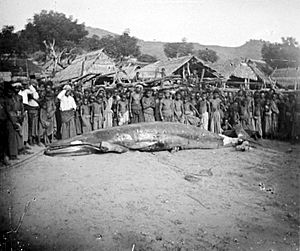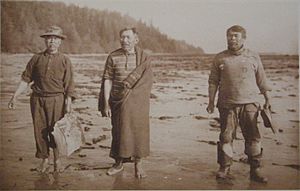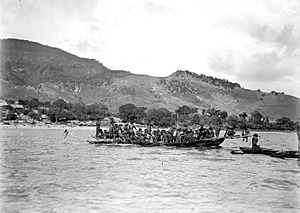Aboriginal whaling facts for kids
Indigenous whaling is when indigenous peoples hunt whales. This type of hunting is allowed by international rules. However, some countries still debate if it should continue. It is often seen as a way for communities to get food and resources they need to live. This is called a subsistence economy. In some areas, people now prefer whale watching over hunting. This article focuses on communities that still hunt whales today.
Contents
Understanding International Whaling Rules
The International Whaling Commission (IWC) set up a ban on whaling in 1986. But they make an exception for indigenous groups. This is called Aboriginal Subsistence Whaling. It means native peoples can hunt whales if it's for their own needs. It's similar to subsistence fishing.
The IWC says that indigenous whaling is different from commercial whaling. It is not part of the ban. The main goals for this type of whaling are:
- To make sure whale species do not become endangered.
- To allow native people to hunt enough whales for their culture and food.
- To help whale populations stay healthy and grow.
For a country to allow this type of hunt, they must show the IWC that their people truly need it. The whales caught cannot be sold for profit or exported to other countries.
Whaling in the United States
In the United States, Alaska Natives and the Makah tribe in Washington State hunt whales. Long ago, native people on the Atlantic coast also understood how to use whales that washed ashore.
Alaska's Whaling Communities
The Alaska Eskimo Whaling Commission manages whaling in the Arctic. This commission works with the National Oceanic and Atmospheric Administration. It includes eleven whaling communities along the Arctic Alaska coast. These are Gambell, Savoonga, Wales, Little Diomede, Kivalina, Point Hope, Point Lay, Wainwright, Barrow, Nuiqsut, and Kaktovik.
In 2015, Alaska Natives caught 326 beluga whales and 49 bowhead whales. In 2016, they caught 59 bowhead whales. They also caught two minke whales and one humpback whale, which were not allowed. But no one was punished for this. Each year, they usually catch 300 to 500 belugas and 40 to 70 bowheads.
The bowhead whales are taken from a group of about 10,000 in Alaskan waters. Some groups against whaling say this hunt is not good for the whales. However, the IWC Scientific Committee believes the bowhead population grows by 3.2% each year. Until 1996, they also caught one or two gray whales yearly. This hunt stopped in 1996 due to worries about the gray whale population.
Washington State's Makah Tribe
By federal law, the Makah people of Washington State can hunt one baleen whale each year. This is usually a gray whale. Old records show they also hunted many humpback whales. The Makah stopped whaling in the 1920s. But in 1995, they told the U.S. Government they wanted to restart their whaling rights.
Their first allowed whale hunt in 70 years happened on May 17, 1999. They caught a North Pacific gray whale. In 2007, they caught another whale without permission. In 2018, they used meat from a humpback whale that died from a ship strike. The government looked into allowing more hunts in 2015.
In 2019, NOAA Fisheries suggested allowing the Makah tribe to hunt. They proposed allowing up to 20 gray whales every five years. But the tribe would still need a permit from NOAA for each hunt.
Whaling in Canada
Canada left the IWC in 1982. This means they do not have to follow the whaling ban. Various Inuit groups in the Canadian Arctic hunt a small number of whales. The Department of Fisheries and Oceans manages these hunts.
Whaling in Russia
People in the Chukotka Autonomous Okrug in the Russian Far East are allowed to hunt whales. They can take up to 140 gray whales each year from the North-East Pacific group.
Whaling in the Caribbean
Some whaling happens in Grenada, Dominica, Saint Vincent and the Grenadines, and Saint Lucia. They hunt short-finned pilot whales, Killer whales, pygmy killer whales, and spinner dolphins. About 400 pilot whales are caught each year in the Caribbean. The meat is sold locally. The IWC does not control the hunting of these smaller whales.
In Bequia, an island in the Grenadines, native people hunt whales. They can catch up to four humpback whales per year. They must use traditional methods, like hand-thrown harpoons from small sailboats. They rarely reach this limit, and some years they catch no whales. Some groups argue that this hunt should not be allowed as "aboriginal." They call it "artisanal whaling out of control."
Whaling in the Faroe Islands
Whalers in the Faroe Islands catch about 800 long-finned pilot whales each year. These hunts are known as grindadráp in the Faroese language.
Whaling in Indonesia
Lamalera and Lamakera are the last two whaling communities in Indonesia. Lamalera is on the island of Lembata, and Lamakera is on nearby Solor. The hunters have special religious rules. These rules make sure they use every part of the whale. About half of the catch stays in the village. The rest is traded in local markets using barter, which means exchanging goods.
The whale hunts are done in a very old way. They use bamboo spears and small wooden boats. These boats are 10–12 meters long and 2 meters wide. They are built without nails. Their sails are made from woven palm leaves. The harpooner kills the animal by jumping from the boat onto its back. Then they drive in the harpoon.
The people of Lamalera hunt several types of whales. They mainly hunt sperm whales. Hunting baleen whales is forbidden for them. In 1969, a busy year, they caught 56 sperm whales. Besides whales, they also hunt dolphins, manta rays, turtles, and different kinds of sharks.
In 1973, the United Nations Food and Agriculture Organization tried to modernize their hunt. They sent a whaling ship and a Norwegian master whaler. But this effort only lasted three years and did not work. The FAO report said that the Lamalerans "have developed a method of whaling that suits their natural resources, cultural beliefs, and way of life."
The World Wide Fund for Nature has studied the village. They want to make sure that the limited hunting does not harm whale populations or other endangered species worldwide.
Issues Affecting Aboriginal Whaling Rights
Commercial whaling and poachers hunt whales in large numbers. They sell them illegally. The International Whaling Commission (IWC) only allows aboriginal subsistence whaling and scientific whaling. These hunts have limits to help protect whales. These groups must report their hunts and how many whales they catch. This helps track whale populations and conservation efforts. Illegal hunting means catches are not reported. This makes it hard to know how many whales are left and to protect them.
Images for kids





